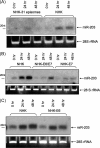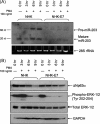Human papillomaviruses modulate expression of microRNA 203 upon epithelial differentiation to control levels of p63 proteins
- PMID: 20219920
- PMCID: PMC2863797
- DOI: 10.1128/JVI.00078-10
Human papillomaviruses modulate expression of microRNA 203 upon epithelial differentiation to control levels of p63 proteins
Abstract
Human papillomaviruses (HPV) link their life cycles to epithelial differentiation and induce productive replication of viral DNA in suprabasal cells. Viral-DNA amplification requires cells to remain active in the cell cycle upon differentiation. This is in contrast to normal cells, which lose proliferative capability upon differentiation. One factor that negatively regulates proliferative capability upon differentiation is microRNA 203 (miR-203), which is expressed primarily in suprabasal epithelial cells. Although HPVs do not encode their own microRNAs (miRNAs), they modulate expression of cellular miRNAs to regulate the activities of cellular proteins. We show that the HPV E7 protein downregulates miR-203 expression upon differentiation, which may occur through the mitogen-activated protein (MAP) kinase/protein kinase C (PKC) pathway. One target of miR-203 is the p63 family of transcription factors, and we demonstrate that HPV-positive cells maintain significantly higher levels of these factors upon differentiation than do normal keratinocytes. Several downstream targets of p63, CARM-1, p21, and Bax, were also increased in E7-expressing cells, and their levels were inversely correlated with amounts of miR-203. Introduction of expression vectors for miR-203 into keratinocytes that stably maintain HPV episomes resulted in short-term elevation of HPV genome copy numbers, but these were rapidly lost upon subsequent passage. When HPV-positive cells expressing high levels of miR-203 were induced to differentiate in methylcellulose, impaired genome amplification was observed. We conclude that high levels of miR-203 are inhibitory to HPV amplification and that HPV proteins act to suppress expression of this microRNA to allow productive replication in differentiating cells.
Figures






Similar articles
-
Human papillomaviruses activate the ATM DNA damage pathway for viral genome amplification upon differentiation.PLoS Pathog. 2009 Oct;5(10):e1000605. doi: 10.1371/journal.ppat.1000605. Epub 2009 Oct 2. PLoS Pathog. 2009. PMID: 19798429 Free PMC article.
-
Suppression of STAT-1 expression by human papillomaviruses is necessary for differentiation-dependent genome amplification and plasmid maintenance.J Virol. 2011 Sep;85(18):9486-94. doi: 10.1128/JVI.05007-11. Epub 2011 Jul 6. J Virol. 2011. PMID: 21734056 Free PMC article.
-
Suppression of MicroRNA 424 Levels by Human Papillomaviruses Is Necessary for Differentiation-Dependent Genome Amplification.J Virol. 2017 Nov 30;91(24):e01712-17. doi: 10.1128/JVI.01712-17. Print 2017 Dec 15. J Virol. 2017. PMID: 28978708 Free PMC article.
-
The human papillomavirus E7 oncoprotein as a regulator of transcription.Virus Res. 2017 Mar 2;231:56-75. doi: 10.1016/j.virusres.2016.10.017. Epub 2016 Nov 8. Virus Res. 2017. PMID: 27818212 Free PMC article. Review.
-
Pathogenesis of human papillomaviruses in differentiating epithelia.Microbiol Mol Biol Rev. 2004 Jun;68(2):362-72. doi: 10.1128/MMBR.68.2.362-372.2004. Microbiol Mol Biol Rev. 2004. PMID: 15187189 Free PMC article. Review.
Cited by
-
The microRNA feedback regulation of p63 in cancer progression.Oncotarget. 2015 Apr 20;6(11):8434-53. doi: 10.18632/oncotarget.3020. Oncotarget. 2015. PMID: 25726529 Free PMC article. Review.
-
Expression of the cervical carcinoma expressed PCNA regulatory (CCEPR) long noncoding RNA is driven by the human papillomavirus E6 protein and modulates cell proliferation independent of PCNA.Virology. 2018 May;518:8-13. doi: 10.1016/j.virol.2018.01.031. Epub 2018 Feb 7. Virology. 2018. PMID: 29427865 Free PMC article.
-
HPV16 and HPV18 Genome Structure, Expression, and Post-Transcriptional Regulation.Int J Mol Sci. 2022 Apr 29;23(9):4943. doi: 10.3390/ijms23094943. Int J Mol Sci. 2022. PMID: 35563334 Free PMC article. Review.
-
Nip the HPV encoded evil in the cancer bud: HPV reshapes TRAILs and signaling landscapes.Cancer Cell Int. 2013 Jun 17;13(1):61. doi: 10.1186/1475-2867-13-61. Cancer Cell Int. 2013. PMID: 23773282 Free PMC article.
-
Post-Transcriptional Regulation of KLF4 by High-Risk Human Papillomaviruses Is Necessary for the Differentiation-Dependent Viral Life Cycle.PLoS Pathog. 2016 Jul 7;12(7):e1005747. doi: 10.1371/journal.ppat.1005747. eCollection 2016 Jul. PLoS Pathog. 2016. PMID: 27386862 Free PMC article.
References
-
- Bostjancic, E., and D. Glavac. 2008. Importance of microRNAs in skin morphogenesis and diseases. Acta Dermatovenerol Alp Panonica Adriat. 17:95-102. - PubMed
-
- Chen, C. Z., L. Li, H. F. Lodish, and D. P. Bartel. 2004. MicroRNAs modulate hematopoietic lineage differentiation. Science 303:83-86. - PubMed
-
- Cheng, S., D. C. Schmidt-Grimminger, T. Murant, T. R. Broker, and L. T. Chow. 1995. Differentiation-dependent up-regulation of the human papillomavirus E7 gene reactivates cellular DNA replication in suprabasal differentiated keratinocytes. Genes Dev. 9:2335-2349. - PubMed
-
- De Laurenzi, V., A. Rossi, A. Terrinoni, D. Barcaroli, M. Levrero, A. Costanzo, R. A. Knight, P. Guerrieri, and G. Melino. 2000. p63 and p73 transactivate differentiation gene promoters in human keratinocytes. Biochem. Biophys. Res. Commun. 273:342-346. - PubMed
Publication types
MeSH terms
Substances
Grants and funding
LinkOut - more resources
Full Text Sources
Research Materials

